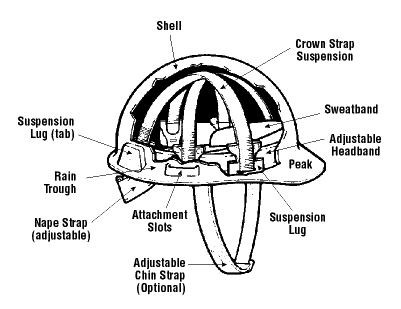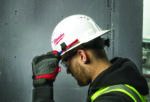Employee’s safety is incomplete without talking about hard hats. These appliances are considered as the most basic yet important gear for head protection.

Saving your head at the workplace is pivotal for your brain health. That is why some professions have made it mandatory for their workers to include hard hats in their daily routine. But how do hard hats actually protect you?
Hard hats are designed to protect your head from concussions, cuts and bruises and in fact severe traumatic injuries which can occur as a result of falling objects and electrical shocks.
Not just your head, the hats ensure safety of your eyes and neck from any impacts, bumps and scrapes. Mandated by OSHA for specific tasks, these hats are water resistant and resist penetration by objects.
In this article, we’ll look at the significance of hard hats, their requirements along with the guidelines of their use. By the end you’ll understand how these hats are successful in saving your head.
OSHA standards for hard hats
According to OSHA standard 1910. 135, it is essential for the employer to make sure that the employees under him or her must have a protective helmet or hard hat if they are working in areas which are prone to injuries.
According to OSHA’s non non mandatory compliance guidelines for hazard assessment and for selection of protective equipment selection, following workers should use hard hats.
-
-
- Carpenters (Best Carpenter Hard Hats Brands)
- Electricians (The Best Hard Hat for Electricians)
- Welders
- Linemen
- Mechanics and repairs
- Timber cutters and loggers
- Sawyers
- Stock handlers and warehouse laborers
- Plumbers and pipefitters
-
Types of Hard hats
There are different classifications of hard hats. These are classified according to their performances and impacts the hats can handle. The ANSI Z89.1-1986 divides the hard hats into two broad categories.
Type 1: The hats which fall in this category have got a full brim which goes around their dome. These helmets save your head from falling objects.
Type 2: These hats don’t feature a full brim but they might have a short rim in the front like the ones which you see in a baseball cap. One great feature about Type 2 is that these have got an inner lining which gives you vertical and lateral protection.
There are some customized hats which are designed to protect you from electrical shocks. The revised standard ANSI Z89.1-1997 classifies these hats into three classes.
Class G (General) Hats: Designed to lessen the impact of falling objects, these hats can handle exposure to low voltage electrical conductors. Hard hats in this category are proof-tested at 2200 volts of electrical charge.
Class E (Electrical) Hats: Known by the name of electrical helmets, these hats not just save your head from falling objects but reduce the danger while you are exposed to high voltage electrical conductors. The hats are certified to handle 20,000 volts of electrical charge.(What Class Of Hard Hat for Electrical Work?)
Class C (Conductive) Hats: As the name suggests, these hats are conductive in nature and thus fail to give you protection against electrical exposures.
How do hard hats protect your head?
Hard hats have various features which make them competent enough to save our heads. What are they? Let’s have a look!
1.) The first and foremost feature which none of us can miss is the presence of the rigid shell which ensures that every blow that your head faces gets deflected. This way, it resists every single injury to your head.
2.) Next comes the inbuilt suspension system which acts as a shock absorber. This system maintains a safe distance between the head and the shell of the hat which is upto one and a half inch.
Interestingly, many employees use this space to store random things which makes these hats less effective. But overall, the space plays quite an important role to prevent you from serious injuries in the skull.

3.) Properly rated hard serve as an insulator against electrical shocks. Although not all hats are insulated. Some are conductive in nature. Therefore it is advisable to select the hard hat according to your profession and workplace.
4.) Lastly, the hat saves your scalp from all kinds of splashes, drips or spills. Infact, it also prevents these liquids from running into your eyes.
You can also wear the hat backwards in case you are having clearance issues in a tight space or when you want to save your neck from all the liquids. Just keep in mind that if you are reversing your hat then the suspension of the hat also gets reserved.
How Much Impact Can Hard Hats Bear?
We have already discussed that different classes of hard hats can resist different amounts of current leakage but if we specifically take impact protection into consideration then both types, 1 and 2 can withstand an 8 pound ball if dropped from a distance of 5 feet on the top of the hat. In this case scenario, the maximum peak force would be around 1000 pounds.
To be well effective in nature, there is another test which both types of hats should qualify. It includes dropping off a 2.2 pounds pointed steel dart from a height of approximately 8 feet on a 3 inch circle at the apex of the hat.
If we particularly talk about Type two then it also involves a test for chin strap retention. For this, a 22.2 pounds is attached to the chin strap which is dropped from a height of 4 inches.
The hats are considered qualified if it’s strap doesn’t elongate more than 1 inch or in extreme cases detach from the hat.
Guidelines for Use of Hard Hats
For hard hats to work well, you have to follow certain guidelines which are designated by OSHA. Follow these for ensuring maximum safety.
→ You are supposed to wear the headgear with the bill facing forward all the time.
→ The hat should fit you properly. It shouldn’t slip, bind, fall off or irritate your skin during action.
→ You should inspect your hat daily to look out for damages.
→ Try not to put any stickers or labels as they may hide the damages if any.
→ Hats should be kept free from any kind of paints, thinner or cleaning agents as they might reduce electrical resistance and also weaken the shell.
→ Don’t put the hats in direct sunlight.
→ Immediately replace the hat if you see any sign of damage or defect.
→ If your hat has sustained any impact, consider replacing it even if there is no damage.
Maintaining your Hard Hat
Use warm and soapy water to clean your hat and let it dry in the air. I would suggest you to not use cleaning products as they can damage the shell of the hat.
If you are going to replace the suspensions then make sure that you purchase the products from the same company. Suspensions need to be replaced at least once every 12 months.
It is recommended to inspect your hat after every use. Manufacturers suggest discarding the hat after five years of use. The service life of a hat starts when you start to use it, not when it is manufactured.
Final Thoughts
It’s always said that prevention is better than cure and most of the cheaper as well. Hard hats have been around for a very long time. They are not expensive and serve a very important purpose of saving you from fatal injuries.
I hope you have understood how these hats work so if you are an employee choose the hat accordingly because you never know when something heavy will come from above.







